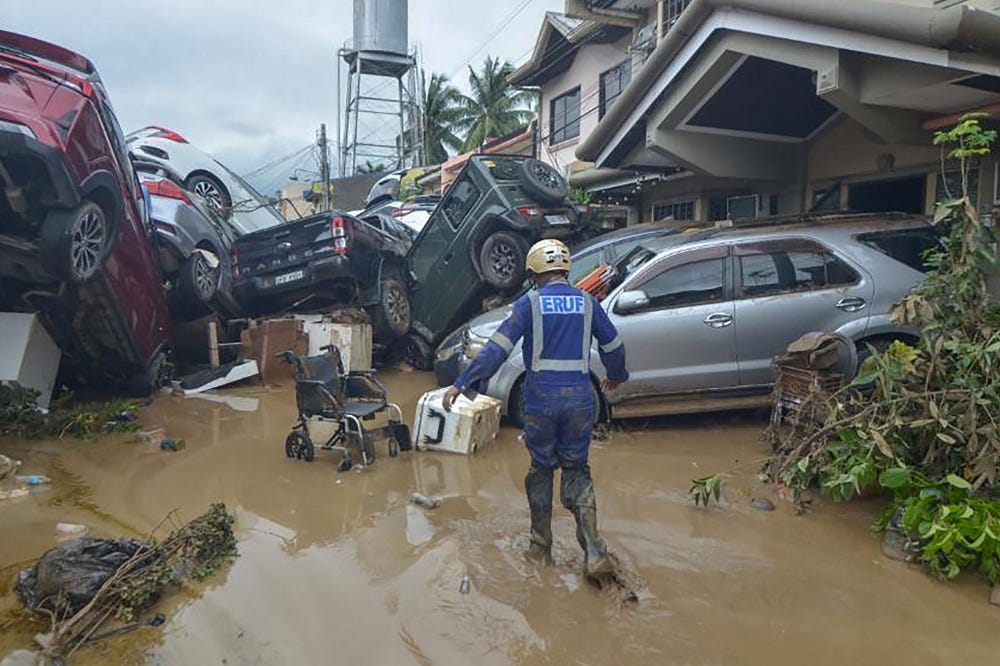Typhoon Kalmaegi Claims Over 100 Lives in Philippines
As grief turns to anger, officials in Cebu raised concerns that alleged corruption in public infrastructure projects may have exacerbated the disaster.
Philiphines, PUREWILAYAH.COM — The death toll from Typhoon Kalmaegi continues to rise in the central Philippines, climbing beyond 100 on Wednesday as authorities uncover the full scale of devastation in Cebu province and neighboring regions.
The province endured its worst flooding in recent memory, with raging waters sweeping away homes, vehicles, and even large shipping containers.
Cebu Province Hit Hard: Dozens Found in Flooded Communities
Cebu authorities reported that the disaster unfolded rapidly, as floodwaters surged through urban and low-lying communities before dawn. Rhon Ramos, spokesperson for the provincial government, confirmed that at least 35 bodies were recovered in Liloan town alone, raising the death toll in Cebu to 76.
Entire neighborhoods were inundated, forcing thousands to flee to rooftops or wade through strong currents. Streets in major districts, including Mandaue and Talisay, turned into violent rivers as a nearby waterway overflowed.
“Around four or five in the morning, the water was so strong that you couldn’t even step outside,” said Reynaldo Vergara, a 53-year-old shop owner in Mandaue.
“Nothing like this has ever happened. The water was raging.”
In Talisay, informal riverside settlements were swept away, leaving families to rebuild from the rubble. “This will take time because I don’t have the money yet. It will take months,” said resident Regie Mallorca, 26, as he mixed cement by hand amid the debris.
Weather officials reported that Cebu received 183 millimeters of rain within 24 hours — far exceeding its monthly average of 131 millimeters and contributing to severe flash floods across the metropolitan area.
Deadly Mudflows on Negros Island
Across the water, tragedy also struck Negros Island, where at least 12 people were killed and another 12 remain missing after heavy rains triggered volcanic mudflows on the slopes of Kanlaon volcano.
Police Lt. Stephen Polinar explained that eruptions over the past year had deposited volcanic material on upper slopes, later liquefied by Kalmaegi’s relentless rainfall and unleashed onto nearby villages in Canlaon City.
Earlier government figures had included just one fatality from Negros. The updated toll also includes six crewmembers of a military helicopter that crashed during a typhoon relief mission.
Anger Mounts Over Corruption in Flood-Control Funds
As grief turns to anger, officials in Cebu raised concerns that alleged corruption in public infrastructure projects may have exacerbated the disaster.
Governor Pamela Baricuatro noted that some areas that suffered unusual flash floods were the same communities where billions of pesos in government flood-control funds had supposedly been allocated on paper — but not seen in real construction.
“You begin to ask why we’re having terrible flash floods here when you have ₱26.6 billion (US$452 million) for flood-control projects in the national budget,” Baricuatro told local media.
She said inspections revealed no structures built to proper standards in certain zones, calling them “ghost projects.”
A spokesperson for the Department of Public Works and Highways said Secretary Vince Dizon traveled to Cebu to evaluate the situation, adding, “After his inspection there, maybe he will comment.”
The scandal has fueled public frustration, with residents expressing shock that critical flood defenses were allegedly never built despite enormous funding.
Climate Risks and Months of Storms Ahead
Kalmaegi is the 20th storm to hit the Philippines this year — meeting the country’s average annual storm count — and meteorologists warn that up to five more severe systems may follow before the end of December.
Scientists have long cautioned that warming oceans and rising atmospheric temperatures are increasing typhoon intensity and rainfall volume, amplifying the human toll in a country where millions live in high-risk, low-income coastal and riverbank communities.
Nearly 800,000 people were evacuated ahead of the storm’s landfall as authorities scrambled to protect at-risk populations.
By Wednesday afternoon, Kalmaegi had moved over the South China Sea toward Vietnam, where authorities warned that existing flood conditions may worsen as the storm advances. (PW)


